Frank's travels around Britain 2008.
Winchester Area.
This time I stayed in the lodge at the Chieveley service station. Not one of their best, it really needs a revamp. Once again I managed to grab some sunshine! How do I do it? The journey down, under grey skies, made me think that my luck was going to change.
The city of Winchester is not really a beautiful place but it is packed with history. It could be any town in modern Britain with upmarket multiple shops, multi-storey car parks & a few vagrants looking for coppers to feed their un-stated habits. History & beauty seemed to be in one area of the city. The very square cathedral looked good in the sunshine and the Wolvesey Castle, under the care of English Heritage, was free to look round, what a wonderful change in rip-off Britain!
 On
these trips, I always seem to come across a little nugget. This trip it was
William Walker M.V.O. To come across a bust of a man in a drivers suit from the
1900s, in a city a long way from the sea, with the annotation "Who saved the
Cathedral with his own hands 1906-1911" was bound to rise the curiosity! On
Wikipedia, I found this amazing story
On
these trips, I always seem to come across a little nugget. This trip it was
William Walker M.V.O. To come across a bust of a man in a drivers suit from the
1900s, in a city a long way from the sea, with the annotation "Who saved the
Cathedral with his own hands 1906-1911" was bound to rise the curiosity! On
Wikipedia, I found this amazing story
"In his time, William Walker was the most experienced diver of
Siebe Gorman Ltd.
Working in water up to a depth of 6
m between
1906-1911,
he shored up the Cathedral using more than 25,000 bags of concrete, 115,000
concrete
blocks and 900,000 bricks! Prior to his work, the Cathedral had been in imminent
danger of collapse as it slowly sank into the ground, which consisted of peat.
To enable bricklayers to build supporting walls, the
groundwater
level had to be lowered. Normally, the removal of the groundwater would have
caused the collapse of the building. So to give temporary support to the
foundation walls some 235 pits were dug out along the southern and eastern sides
of the building, each about six metres deep. Walker went down and shored up the
walls by putting concrete underneath them. He worked for 6 hours a day over six
years, in complete darkness because of the sediment.
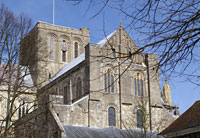
His full name was William Robert, he was six feet tall and weighing 14 stone. His regular attendant, operating the vital air pump was William West. For almost six years, from April 1906 - September 1911, Bill spent up to six hours a day in narrow waterlogged pits and drifts dug up to 24 feet under the Cathedral walls, small bags of concrete were laid in four to eight courses, like brickwork. Once in position, each layer was split open - so it would bond with the next. On completion the water could safely be pumped out and ordinary workmen finished the course to the underside of the walls. Approximately 235 such excavations were carried out..
For his outstanding feat, Walker was honoured with the title " Member of the
Royal Victorian Order". Astonishingly, after this almost unbelievable effort in
saving a church that goes back to the year 642, which was the capital of England
and the
centre of King Alfreds kingdom, this man was given an order that is the
second-most junior order of chivalry in the
British honours system
(in terms of both age and precedence) & he held the lowest class in an order
that includes five classes! He died during the
Spanish flu
epidemic of
1918. To
add insult to injury, there was a complete cock up on a statue that was meant to
be of Bill & the story of that alone, is worth a read!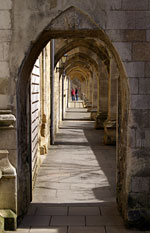
 There is a huge statue of King Alfred (or as it was spelt on the plinth,
Aelfred). This is the king of the southern
Anglo-Saxon
kingdom of
Wessex
from
871 to
899. The
one, who according to legend, burnt the cakes of a peasant women. I can remember
being told this story at school. I think it was used it illustrate that even a
King or great leader should acknowledge, to even a humble peasant, when he
was wrong. I also noticed that the teachers & leaders I knew, seldom took their
own advice! We are now in the era of "Danegelt" A tax levied in England from the
10th to the 12th century to finance protection against Danish invasion.
The
Vikings dominated England, Scotland, and Ireland for a couple of centuries, in
the case of Britain from 787 to the Norman Conquest in 1066. Aelfred was the
fifth child of Ethelwulf, King of Wessex and Queen Osburgh. His early life was
spent mostly in the court of his parents, and he was much influenced by them in
matters of learning and religion. Ethelwulf, before acceding to the throne of
Wessex, was educated at the Old Minster in Winchester, by Bishop Swithun.
There is a huge statue of King Alfred (or as it was spelt on the plinth,
Aelfred). This is the king of the southern
Anglo-Saxon
kingdom of
Wessex
from
871 to
899. The
one, who according to legend, burnt the cakes of a peasant women. I can remember
being told this story at school. I think it was used it illustrate that even a
King or great leader should acknowledge, to even a humble peasant, when he
was wrong. I also noticed that the teachers & leaders I knew, seldom took their
own advice! We are now in the era of "Danegelt" A tax levied in England from the
10th to the 12th century to finance protection against Danish invasion.
The
Vikings dominated England, Scotland, and Ireland for a couple of centuries, in
the case of Britain from 787 to the Norman Conquest in 1066. Aelfred was the
fifth child of Ethelwulf, King of Wessex and Queen Osburgh. His early life was
spent mostly in the court of his parents, and he was much influenced by them in
matters of learning and religion. Ethelwulf, before acceding to the throne of
Wessex, was educated at the Old Minster in Winchester, by Bishop Swithun.
Saint Swithun (died
2 July
862) was an early
English
Bishop of Winchester,
now best known for the popular
British
weather lore
proverb
that if it rains on Saint Swithun's day,
15 July,
it will rain for 40 days and 40 nights. Swithun was buried out of doors, rather
than in
his cathedral,
apparently at his own request, so that the "sweet rain of heaven" could fall on
his grave. Popular legend insists that the monks tried to move Swithun inside
the Old Minster, some nine years after his death. The saint, however, did not
approve of his removal from exposure to the elements. There was a clap of
thunder and it began to rain for forty days and forty nights! I just love the
thought that that could be true!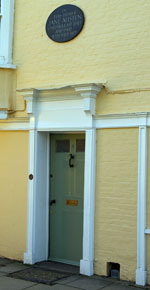
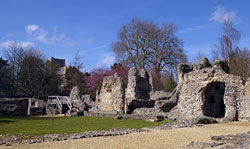 After
passing through the old part of town I saw the house Jane Austin
lived in and was her final home. Jane's funeral was held in
Winchester Cathedral and she was buried in the north aisle. Just
as her novels were published anonymously, the inscription on her
tomb makes no mention of her literary talents. The signs I
followed led me to Wolvesey Castle, a
ruined
castle
behind the Cathedral. It was erected by the
Bishop of
Winchester
Henry of
Blois between
1130
and
1140.
Begun as a 12th-century Norman keep and bailey castle, the
palace was the chief residence of the Bishops of Winchester. It
was once a very important building, and was the location on
July 25,
1554
of the
wedding
breakfast of
Queen Mary
and
Philip II
of Spain. The castle destruction was helped by
Roundheads
during the
English
Civil War in
1646.
After
passing through the old part of town I saw the house Jane Austin
lived in and was her final home. Jane's funeral was held in
Winchester Cathedral and she was buried in the north aisle. Just
as her novels were published anonymously, the inscription on her
tomb makes no mention of her literary talents. The signs I
followed led me to Wolvesey Castle, a
ruined
castle
behind the Cathedral. It was erected by the
Bishop of
Winchester
Henry of
Blois between
1130
and
1140.
Begun as a 12th-century Norman keep and bailey castle, the
palace was the chief residence of the Bishops of Winchester. It
was once a very important building, and was the location on
July 25,
1554
of the
wedding
breakfast of
Queen Mary
and
Philip II
of Spain. The castle destruction was helped by
Roundheads
during the
English
Civil War in
1646.
![]() This trip was soon after the clocks had changed. Being nearly
70, slightly stupid and in bright sunshine I decided to visit
Beacon Hill. Only 261 metres high! I thought it was a great
chance to photograph the lovely countryside. Sometime around
7pm, I found myself out of breath, pounding heart & burning
muscles being passed by some 40 year olds who were smoking a fags half way
up this "hill"! Beacon Hill is near the village of
Burghclere,
in north
Hampshire.
The hill's name is derived from the fact that it was once the
site of the most famous
beacon
in Hampshire and has one of
England's
most well known
hill forts
on its slopes. I made it half way up, decided I needed food &
rest more than an early death through exhaustion and contented
myself with a "half way up Beacon Hill" photograph. I took the
shadow of me to prove that I made it, in case I passed away on
the return to the car!
This trip was soon after the clocks had changed. Being nearly
70, slightly stupid and in bright sunshine I decided to visit
Beacon Hill. Only 261 metres high! I thought it was a great
chance to photograph the lovely countryside. Sometime around
7pm, I found myself out of breath, pounding heart & burning
muscles being passed by some 40 year olds who were smoking a fags half way
up this "hill"! Beacon Hill is near the village of
Burghclere,
in north
Hampshire.
The hill's name is derived from the fact that it was once the
site of the most famous
beacon
in Hampshire and has one of
England's
most well known
hill forts
on its slopes. I made it half way up, decided I needed food &
rest more than an early death through exhaustion and contented
myself with a "half way up Beacon Hill" photograph. I took the
shadow of me to prove that I made it, in case I passed away on
the return to the car!
The next day was bright but overcast with an odd shower. It was
still very nice but the dullness took the punch out of the
photographs. The towns were for passing by & the villages are
now the typical pretty, middle class ghettoes and devoid of any
sign of life.
No one walks around, there are no shops and they lock their
churches. (to be fair, the days of churches you can go inside
are passed).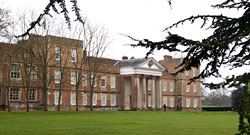
Looking round for photographs, I found The Vyne. A 16th-century house, dating back to Henry VIII's reign. It would have been lovely to record in the sunshine. perhaps a little to early to show the garden at its best. The lack of sunshine deadened the reflections in the water but its a very pleasant place. I think I am ruined by Castle Combe, Rye & the Cotswolds. This area is for the rich to live in & commute to their money fountains. Its for passing through, not for anyone looking for eye candy.
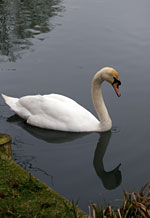 The Vyne was built for
Lord Sandys,
King
Henry VIII's
Lord
Chamberlain. The house retains its Tudor
chapel, with stained glass. During the Civil War the house was a
Parliamentarian stronghold. In the mid-18th century. The Vyne belonged to
Horace
Walpole's close friend John Chaloner Chute who
bought it around 1653.
He added the classical
portico
on the north front in 1654, designed by
Inigo Jones's
pupil
John Webb.
The Vyne was built for
Lord Sandys,
King
Henry VIII's
Lord
Chamberlain. The house retains its Tudor
chapel, with stained glass. During the Civil War the house was a
Parliamentarian stronghold. In the mid-18th century. The Vyne belonged to
Horace
Walpole's close friend John Chaloner Chute who
bought it around 1653.
He added the classical
portico
on the north front in 1654, designed by
Inigo Jones's
pupil
John Webb.

The whole place looks like its been lived in, lots of changes & a slightly scruffy look. The National Trust seem to be trying to be so modern with low carbon footprint toilets & the recycling of water, while the huge house they are trying to preserve for the future has heating costs must be crippling & have the carbon footprint of modern housing estate. Each year a number of concerts, plays and family events are run. Looking at the prices, I could see only the rich can afford to attend. Hold your wedding here & you can show the world your standing. "One was married at a place Henry VIII visited several times and Elizabeth I was also a visitor". The lakes & garden is very nice. I love the reflections you can get in water. The light was just dulling it all down. I do like the way the National trust encourages nature, makes such lovely walks & preserves our heritage. I just sag at the costs of it all.
Links for
information on this page:
